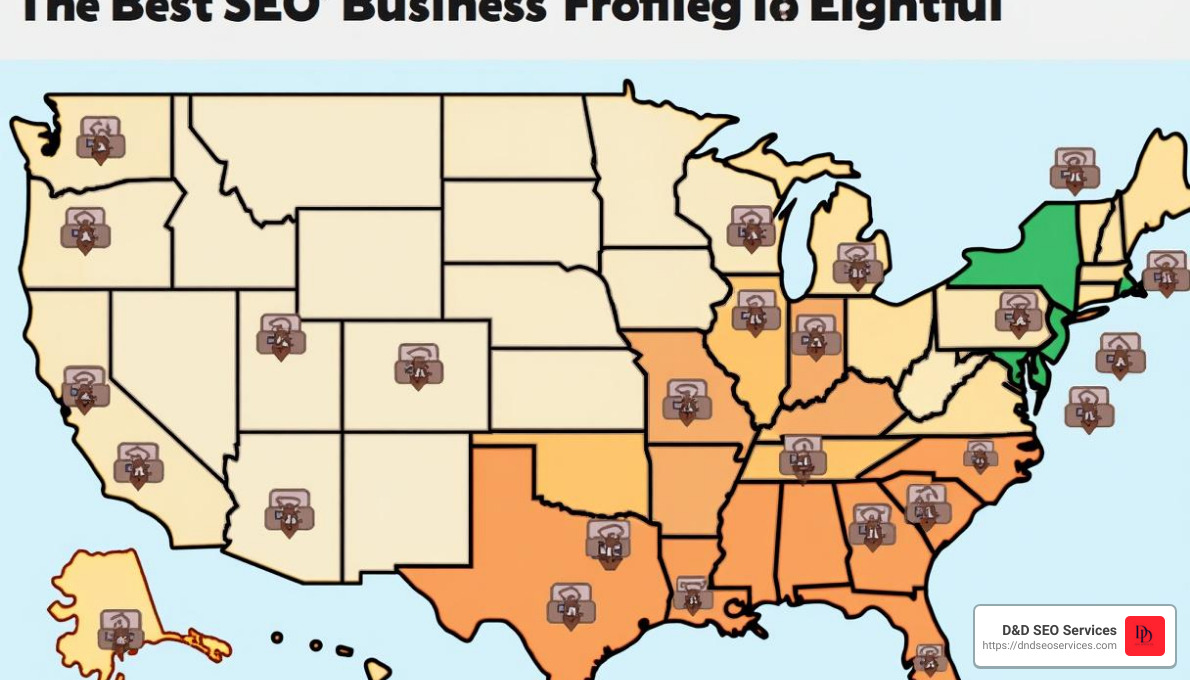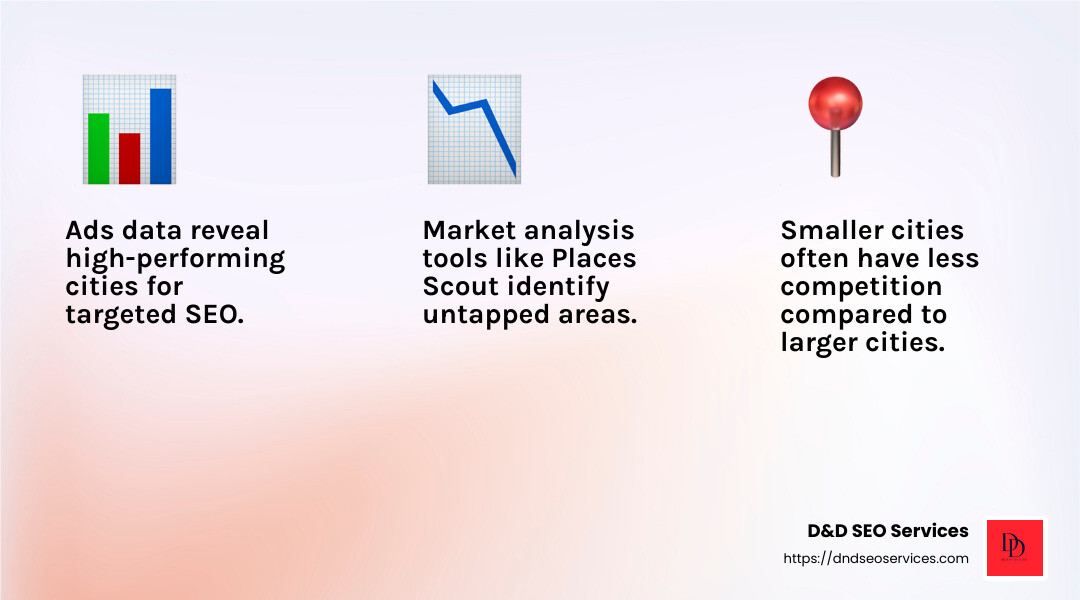Open uping Local Success: How to Choose Locations for Service Area Pages
How do you pick locations that need Service Area Pages? This is a common question for small business owners aiming to improve local SEO and attract more customers. Here’s a quick answer:
- Analyze Ads Data: Identify high-performing cities from your ad campaigns.
- Evaluate Conversion Rates: Focus on areas with the highest customer engagement.
- Consider Small Cities: These can often be untapped goldmines.
- Assess Competition: Use tools like Places Scout to find locations with less competition but high potential.
Service area pages are essential for businesses that serve multiple locations but don’t have a physical presence in each one. By targeting the right locations, you can significantly boost your online visibility and attract more local customers.
I’m Danielle Birriel, founder of D&D SEO Services, with over a decade of experience in local SEO. My aim is to empower small businesses like yours to thrive online. With this guide, I’ll show you the easiest way to identify where your service area pages should be, ensuring you make the most impact.
Important How do you pick locations that need Service Area Pages? terms:
- local on-page seo for multi-location
- on page local seo
- why on page seo matters for local businesses
Understanding Service Area Pages
Service area pages are crucial for businesses that provide services in multiple locations but don’t have a physical presence in each one. These pages help you target specific geographic areas, improving your local SEO and attracting more customers from those regions.
Definition and Purpose
Service area pages are dedicated web pages that highlight the services you offer in specific locations. Unlike location pages, which require a physical address, service area pages focus on the areas you serve.
The main purpose of these pages is to:
- Increase local visibility: Help your business appear in local search results for specific areas.
- Attract local customers: Draw in potential clients from different regions.
- Improve SEO: Boost your search engine rankings for local queries.
Local SEO and Service Area Businesses
Local SEO is the practice of optimizing your online presence to attract more business from relevant local searches. It’s especially important for service area businesses, which are businesses that visit or deliver to customers directly but don’t serve them at a fixed location.
Examples of service area businesses include:
- Cleaning services
- Plumbers
- Electricians
- Landscapers
For these businesses, service area pages are a game-changer. They help Google understand where you offer your services, which can significantly improve your chances of appearing in local searches.
Why Service Area Pages Matter
- Targeted Traffic: By creating pages for specific locations, you attract visitors who are more likely to convert into customers.
- Reduced Competition: Smaller cities often have less competition, making it easier to rank higher in search results.
- Higher Conversion Rates: People searching for local services are usually ready to make a purchase, leading to higher conversion rates.
For example, a study by Sterling Sky showed that service area pages with similar content can still increase traffic if they are well-optimized for local searches.
Practical Example
Consider an injury attorney in New York City serving Manhattan, Brooklyn, and Queens. They might create separate service area pages for each borough, such as “Car Accident Lawyer in Manhattan,” “Car Accident Lawyer in Brooklyn,” and “Car Accident Lawyer in Queens.” This targeted approach can lead to better rankings and more inquiries from each specific area.
By understanding the importance of service area pages, you can take the first step in boosting your local SEO and attracting more customers from different regions.
Next, let’s dive into How do you pick locations that need Service Area Pages?
How do you pick locations that need Service Area Pages?
Using Ads Data to Identify Locations
The most effective way to identify which locations need service area pages is by leveraging ads data. If you run PPC campaigns, you already have a treasure trove of information at your fingertips.
Ads Insights and Conversion Tracking
Start by looking at your ad performance data to see which cities generate the most conversions. You can find this data under “Insights and Reports” > “When & where ads showed” > “Matched Locations.” Focus on cities with high conversion rates, as these are likely to be the most lucrative.
High-Performing Cities
Interestingly, smaller cities often outperform larger ones. These cities usually have less competition, making it easier to rank higher in search results. For example, if you’re a plumber, targeting a smaller city with fewer competitors can lead to more conversions than targeting a large, highly competitive city.
Tools for Market Analysis
What if you don’t have ads data? No worries! Tools like Places Scout can come to your rescue.
Market and Competition Analysis
Places Scout provides a deep analysis of your market and competition. You can track your rankings on a grid for your most important keywords and see where you do not currently rank. This helps you identify untapped areas where your services are needed but not yet found.
Untapped Areas
By analyzing organic rankings, Places Scout can reveal regions that are ripe for targeting. This is especially useful for service area businesses that thrive on local SEO. You can find gaps in the market and create service area pages to fill those gaps.
Practical Example
Imagine you own a landscaping company. Using Places Scout, you find that you rank well in the city center but poorly in the outskirts. You can then create service area pages targeting these untapped suburbs, like “Landscaping Services in [Suburb Name].”
By using ads data and market analysis tools, you can strategically choose locations that will benefit the most from service area pages. This targeted approach not only improves your local SEO but also attracts more customers from specific regions.
Next, let’s dive into Best Practices for Creating Effective Service Area Pages.
Best Practices for Creating Effective Service Area Pages
Content Strategy and Internal Linking
Creating effective service area pages starts with a solid content strategy. Each page should clearly describe the service offered and be custom to the specific location it targets. Avoid keyword cannibalization by making sure each page is unique and doesn’t overlap with other service or city pages.
Internal linking is crucial for SEO. Link your service area pages to relevant city pages and main service pages. This helps search engines understand the structure of your site and improves user navigation.
Example:
If you have a “HVAC Repair in Austin” page, link it to your main “HVAC Repair” service page and your “Austin” city page. This not only aids in SEO but also provides a better user experience.
Local Keywords and Customer Testimonials
Incorporating local keywords is essential for ranking in local searches. Use phrases like “near me” and include the city or neighborhood name in your content. This helps capture users looking for services in specific areas.
Customer testimonials add credibility and trust. Showcase reviews from clients in the targeted location to make the page more relatable and trustworthy.
Example:
If you’re targeting “Plumbing Services in Dallas,” include keywords like “plumber near me in Dallas” and add a testimonial from a satisfied Dallas customer.
Showcasing Jobs and Services
Highlighting job stories and service descriptions can make your service area pages stand out. Include detailed descriptions of the services you offer and share stories of past jobs completed in the area.
Visual content like photos and videos can significantly improve your pages. Show before-and-after photos of projects or a video testimonial from a local customer. This not only engages visitors but also builds trust.
Example:
For a “Roof Repair in Chicago” page, include photos of roof repairs you’ve completed in Chicago and a video testimonial from a Chicago homeowner.
By focusing on a robust content strategy, effective internal linking, local keywords, customer testimonials, and showcasing jobs and services, you can create service area pages that not only rank well but also convert visitors into customers.
Frequently Asked Questions about Service Area Pages
Do service area businesses appear on Google Maps?
Yes, service area businesses (SABs) can appear on Google Maps, but there are specific rules. Unlike storefront businesses, SABs do not list a physical address. Instead, they specify the areas they serve. This is crucial for businesses like plumbers or cleaning services that visit customers directly.
Key Points:
- Service Area Boundaries: You can set up to 20 service areas based on cities, postal codes, or other types of areas.
- Google Business Profile: Ensure your business profile accurately reflects your service areas without listing a physical address if you don’t serve customers there.
What is the difference between location pages and service area pages?
Location pages are for businesses with a physical address where customers can visit. These pages often include details like the address, hours of operation, and contact information. They are essential for businesses like restaurants or retail stores.
Service area pages, on the other hand, are for businesses that serve customers directly at their location but do not have a storefront for customer visits. These pages focus on the geographic areas the business serves and the services provided in those areas.
Key Differences:
- Physical Address: Location pages list a physical address; service area pages do not.
- Google Business Profile: Location pages need a Google Business Profile with a physical address. Service area businesses should clear the address field and only enter their service areas.
How do service area pages impact local SEO?
Service area pages can significantly boost local SEO by helping businesses appear in local search results and the local pack. The local pack is the prime real estate on Google’s search results page, featuring the top local businesses related to the search query.
Impact on Rankings:
- Local Pack Rankings: By optimizing service area pages with local keywords and unique content, businesses can improve their chances of appearing in the local pack.
- Organic Rankings: Well-crafted service area pages can also improve organic search rankings by providing relevant, location-specific content that search engines value.
- Customer Engagement: Including customer testimonials, job stories, and visual content can boost engagement and build trust, further improving SEO performance.
By understanding these elements, businesses can effectively use service area pages to improve their local SEO strategy and attract more local customers.
Conclusion
At D&D SEO Services, we understand that no two businesses are the same. That’s why we offer personalized strategies custom to fit your specific needs.
Local Markets
Local SEO is more crucial than ever. According to recent data, 46% of all Google searches are looking for local information. This means a strong local SEO strategy can significantly boost your online visibility and attract more customers from your community. Our strategies are designed to help you dominate local search results, ensuring your business stands out.
Online Visibility
Good online visibility is essential for any business. Our team uses cutting-edge optimization techniques to improve your website’s performance. By integrating tools like Google Analytics and heatmap generators, we track user behavior to understand what works and what doesn’t. This data-driven approach allows us to make informed decisions that improve your online presence.
Business Growth
Our ultimate goal is to drive business growth for our clients. We achieve this by focusing on both short-term wins and long-term strategies. Whether it’s through optimizing your website for conversions or implementing effective content marketing, we ensure that every aspect of your digital presence is fine-tuned for success.
Ready to open up the power of local search optimization for your business? Contact us today to get started on your journey to online success!








